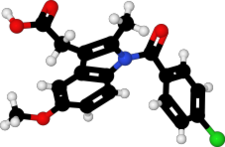User:Mr. Ibrahem/Indometacin
 | |
 | |
| Clinical data | |
|---|---|
| Pronunciation | /ɪndoʊˈmɛtəsɪn/ |
| Trade names | Indocid, Indocin, others |
| Other names | Indomethacin (USAN US) |
| AHFS/Drugs.com | Monograph |
| License data |
|
| Pregnancy category |
|
| Routes of administration | By mouth, rectal, IV, topical |
| Drug class | NSAID[1] |
| Legal status | |
| Legal status | |
| Pharmacokinetic data | |
| Bioavailability | ~100% (oral), 80–90% (rectal) |
| Protein binding | 99%[2] |
| Metabolism | Liver |
| Elimination half-life | 2.6-11.2 hours (adults), 12-28 hours (babies)[2] |
| Excretion | Kidney (60%), fecal (33%) |
| Identifiers | |
| |
| Chemical and physical data | |
| Formula | C19H16ClNO4 |
| Molar mass | 357.79 g·mol−1 |
| 3D model (JSmol) | |
| |
| |
| (verify) | |
Indometacin, also known as indomethacin, is a nonsteroidal anti-inflammatory drug (NSAID) primarily used for pain and inflammation.[3] This may include painful periods, gout, arthritis, and pericarditis.[3][1] Other uses include to close a patent ductus arteriosus is a premature baby.[1] It may be used by mouth, in the rectum, or by injection.[1]
Common side effects include, nausea, heart burn, and dizziness.[1] Severe side effects may include cardiovascular disease, gastrointestinal bleeding, hair failure, kidney injury, and allergic reactions.[1] Use is not recommended during the last third of pregnancy.[3] Indometacin works by decreasing the production of prostaglandin by the enzyme cyclooxygenase.[1]
Indometacin was patented in 1961 and approved for medical use in 1963.[4][5] It is available as a generic medication and marketed under a number of trade names.[6][3] As of 2015 the cost for a typical month of medication in the United States is less than 25 USD.[7] In the United Kingdom this amount costs the NHS less than 5 pounds as of 2020.[3] In 2017, it was the 291st most commonly prescribed medication in the United States, with more than one million prescriptions.[8][9]
References[edit]
- ^ a b c d e f g "Indomethacin Monograph for Professionals". Drugs.com. Retrieved 8 October 2020.
- ^ a b Brayfield A, ed. (14 January 2014). "Indometacin". Martindale: The Complete Drug Reference. London, UK: Pharmaceutical Press. Retrieved 22 June 2014.
- ^ a b c d e BNF 79 : March 2020. London: Royal Pharmaceutical Society. 2020. p. 1180. ISBN 9780857113658.
- ^ Fischer, Jnos; Ganellin, C. Robin (2006). Analogue-based Drug Discovery. John Wiley & Sons. p. 517. ISBN 9783527607495.
{{cite book}}: Unknown parameter|name-list-format=ignored (|name-list-style=suggested) (help) - ^ Hart FD, Boardman PL (October 1963). "Indomethacin: A New Non-steroid Anti-inflammatory Agent". British Medical Journal. 2 (5363): 965–70. doi:10.1136/bmj.2.5363.965. PMC 1873102. PMID 14056924.
- ^ "Indomethacin". go.drugbank.com. Retrieved 8 October 2020.
- ^ Hamilton, Richart (2015). Tarascon Pocket Pharmacopoeia 2015 Deluxe Lab-Coat Edition. Jones & Bartlett Learning. p. 8. ISBN 9781284057560.
{{cite book}}: Unknown parameter|name-list-format=ignored (|name-list-style=suggested) (help) - ^ "The Top 300 of 2020". ClinCalc. Retrieved 11 April 2020.
- ^ "Indomethacin - Drug Usage Statistics". ClinCalc. Retrieved 11 April 2020.
